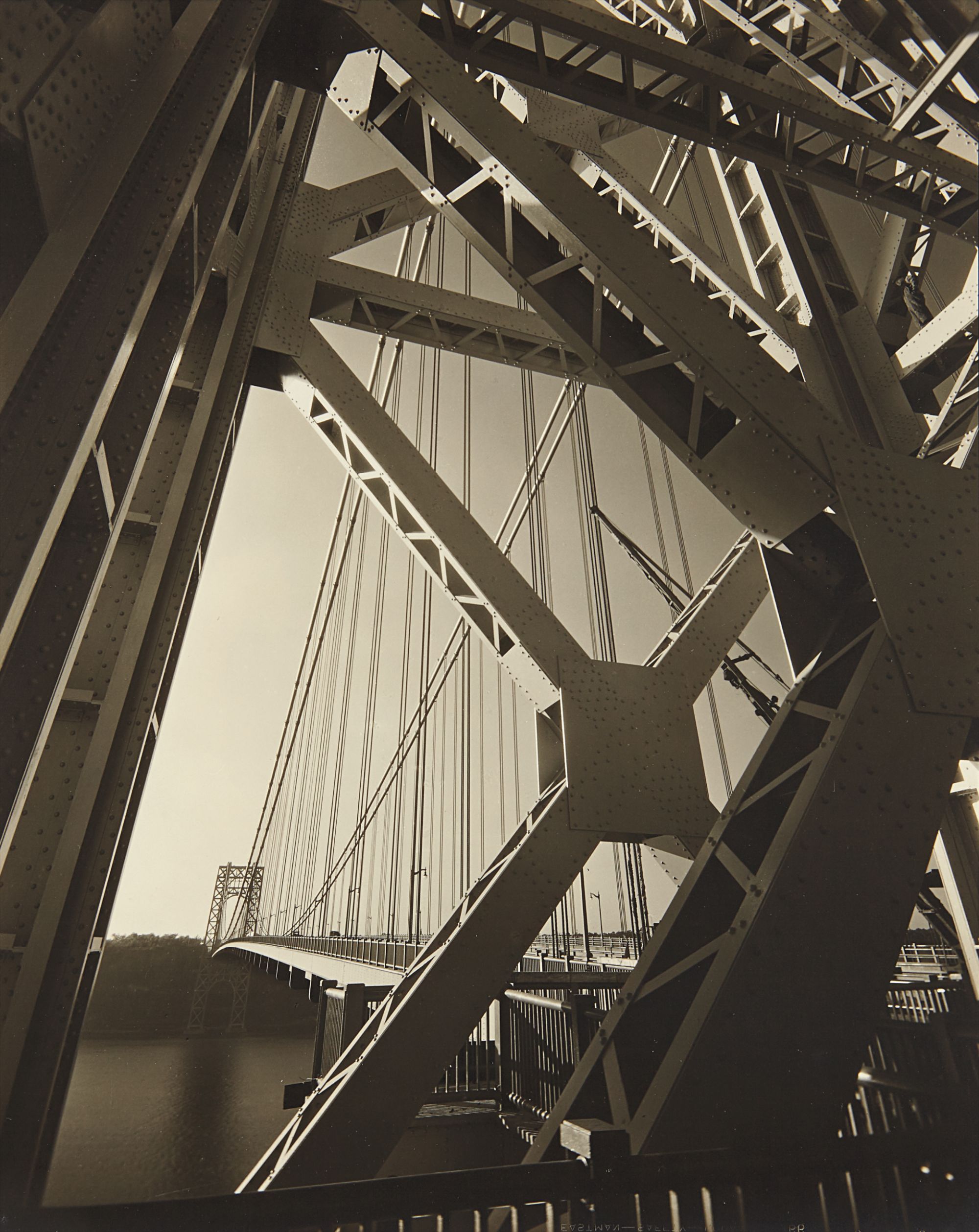

11
Edward Steichen
George Washington Bridge, New York
1931
Gelatin silver print.
9 1/2 x 7 1/2 in. (24.1 x 19.1 cm)
Full-Cataloguing
When asked by Lincoln Kirstein to submit a mural for the opening exhibition of the Museum of Modern Art’s new location at 11 West 53rd Street, Edward Steichen chose an image of the George Washington Bridge. In doing so Kirstein went around his chosen curator’s (the art dealer Julian Levy) back, promising Steichen the prize money for his submission. Kirstein, a member of the Museum’s Advisory Committee, had advocated the exhibition to the museum’s founding Director Alfred H. Barr, Jr., and wanted to make sure that Steichen would be in the first exhibition of photography at the Museum of Modern Art.
At the time of the 1932 opening exhibition Murals by American Painters and Photographers, Steichen ran a commercial studio in downtown Manhattan and was the chief photographer for Condé Nast Publications (1923-1938). He was the most recognized, and highest paid, photographer in the world. As with his earlier work, when he was aligned with Alfred Stieglitz and the Photo-Secession, Steichen was best known for his portrait photography such as J. P. Morgan, 1903 and Greta Garbo, 1928. But when invited to create a work of modern art for the new museum (founded in 1929) he chose an image of steel, enlarged to the immense size of 10’ high by 8 ‘wide.
Though taken from a slightly different vantage point than the George Washington Bridge photograph used for Steichen’s mural, the present lot is an equally modern vision of man’s advancement through the technological achievement of industry. In this rare photograph (only three prints of it are known to exist, one in Museum Folkwang, Essen, the second was in The Joy of Giving Something Collection and sold at auction in 2014) the long expanse of the bridge is seen through its powerful girders that appear to burst beyond the picture frame. It is a dynamic modern image that was created the year the George Washington Bridge (then the longest bridge in the world) was opened.
While Steichen’s 1931 photographs of the George Washington Bridge created images that reflected America’s triumphant optimism wrought out in steel, today’s contemporary photographers present a very different picture. Starting in the late 1960s with Bernd and Hilla Becher’s cool look at industrial structures of past eras and Robert Adams’ minimal landscapes of post WWII sprawl, post-modern photographers such as Andreas Gursky and Edward Burtynsky often mirror in their images our collective unease with global commercialization and its environmentally destructive byproducts. But despite their contrasting approaches, the photographs of both Steichen and his contemporary successors stand as icons of their moments in history.
At the time of the 1932 opening exhibition Murals by American Painters and Photographers, Steichen ran a commercial studio in downtown Manhattan and was the chief photographer for Condé Nast Publications (1923-1938). He was the most recognized, and highest paid, photographer in the world. As with his earlier work, when he was aligned with Alfred Stieglitz and the Photo-Secession, Steichen was best known for his portrait photography such as J. P. Morgan, 1903 and Greta Garbo, 1928. But when invited to create a work of modern art for the new museum (founded in 1929) he chose an image of steel, enlarged to the immense size of 10’ high by 8 ‘wide.
Though taken from a slightly different vantage point than the George Washington Bridge photograph used for Steichen’s mural, the present lot is an equally modern vision of man’s advancement through the technological achievement of industry. In this rare photograph (only three prints of it are known to exist, one in Museum Folkwang, Essen, the second was in The Joy of Giving Something Collection and sold at auction in 2014) the long expanse of the bridge is seen through its powerful girders that appear to burst beyond the picture frame. It is a dynamic modern image that was created the year the George Washington Bridge (then the longest bridge in the world) was opened.
While Steichen’s 1931 photographs of the George Washington Bridge created images that reflected America’s triumphant optimism wrought out in steel, today’s contemporary photographers present a very different picture. Starting in the late 1960s with Bernd and Hilla Becher’s cool look at industrial structures of past eras and Robert Adams’ minimal landscapes of post WWII sprawl, post-modern photographers such as Andreas Gursky and Edward Burtynsky often mirror in their images our collective unease with global commercialization and its environmentally destructive byproducts. But despite their contrasting approaches, the photographs of both Steichen and his contemporary successors stand as icons of their moments in history.